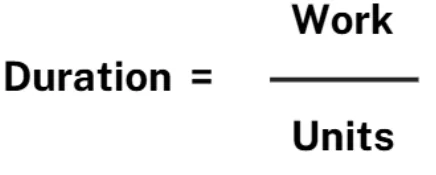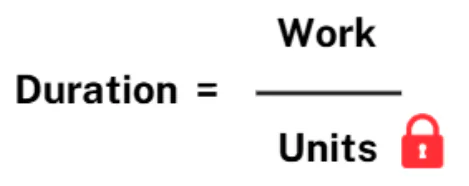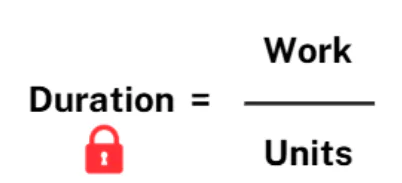Have you ever wondered how the task duration is calculated in Project schedules? It all boils down to simple duration equation.
In this article, I’ll help you understand Project Task Types. Understanding Fixed Units, Fixed Work, and Fixed Duration – can be crucial for managing your project effectively.
These Task Types determine how project scheduling behaves when you make changes to the Duration, Work, or Units values tasks. Let’s break down each Task Type and when to use them.
The Mystery Equation
In the background, scheduling engines such as Microsoft Project uses a simple duration equation to calculate the task duration.

Units represent percentage assignment of Resource. In most scheduling engines 1 Unit is equivalent to:
1 Unit = 100% = 8 hours 0.5 Unit = 50% = 4 Hours
What is Task Type?
The Microsoft Project Task Types feature allows you to fix or “lock” one of three variables in the Duration Equation: Units, Work, or Duration.

The Microsoft Project Task Types feature allows you to fix or “lock” one of three variables in the Duration Equation: Units, Work, or Duration.
This locking ensures that when you change one variable, Microsoft Project recalculates another value accordingly, maintaining consistency in your project plan.
This leads to three task types:
- Fixed Units
- Fixed Duration
- Fixed Work
Fixed Units Task
The Units value is locked. When you change the Work, Microsoft Project recalculates Duration.

task 1 is Fixed Units.

Task 1 work is changed from 24 hrs to 35 hrs. Task Duration changes without changing the units value.

Similarly, when you change the Duration, Microsoft Project recalculates Work.
When to use Fixed Units Tasks?
Use Fixed Units Tasks when the availability of a resource is limited, such as part-time resources.
You can also use Fixed Units when you have highly skilled resources working on your project. For e.g. Machine Learning Engineer. You want his availability to be fixed on your project.
When you set Fixed Units, Microsoft Project locks the Units value, but you can freely adjust Work or Duration.
Fixed Duration Task
The Duration value is locked. When you change the Units, Microsoft Project recalculates Work.

Task 3 is Fixed Duration

task 3 Units are changed from 100% to 50%. Task Work changes without changing the Duration value

Similarly, when you change Work, Microsoft Project recalculates Units.
When to use Fixed Duration Tasks?
Use Fixed Duration Tasks when a task must be completed within a specific time window.
For e.g. delivering a training program. If training program is for 2 days, you can use Fixed Duration task type.
Some testing activities can also modeled as Fixed Duration activities. For e.g. server must be tested for 30 days to check its various performance parameters before making it available into production environment.
Fixed Work Tasks
The Work value is locked. When you change the Duration, Microsoft Project recalculates Units.

Task 2 is Fixed Work

task 2 Duration is changed from 4 days to 6 days. Task Units changes without changing the Work value.

Similarly, when you change Units, Microsoft Project recalculates Duration.
When to use Fixed Work Task?
Use Fixed Work tasks where the amount of Work is fixed, often due to contractual obligations.
For e.g. if you hire a consultant on your project, who will work for 40 hours. You can use Fixed work tasks, because contractually consultant suppose to work for 40 hours – not for 38 hours or 42 hours.
You can also use fixed work tasks when you hire a machine such as high performance computer to run a simulation. In this case you will hire a machine for fixed number of hours for your project.
Summary
Understanding Task Types empowers you to make informed decisions about scheduling and resource management in your projects. Whether you’re dealing with part-time resources, fixed contracts, or strict deadlines, choosing the right Task Type ensures your project stays on track.
Do you want to Master the World’s Most Popular Project Management Tool?
Check out my 18 Hours LIVE Online Course on Microsoft Projects.
Did you know that nearly 60% of Project Management roles posted on LinkedIn require Microsoft Projects skills?
Microsoft Projects, a project management software in use since 1984, stands out as the most established and widely utilized tool across various industries.
Major players like Fortune 500 companies rely on this software to propel their projects forward. Stay ahead of the curve. Acquire this valuable skill now and set yourself apart from other project managers.
For additional information:
Visit the course web-page: pmfornonpm.in/new-courses/




